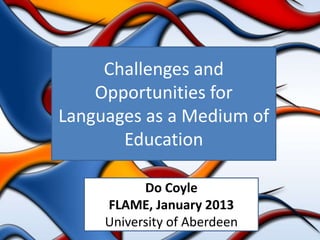
Flame
- 1. Challenges and Opportunities for Languages as a Medium of Education Do Coyle FLAME, January 2013 University of Aberdeen
- 2. Key Messages • CLIL is viral - debunking some myths • CLIL is about ‘meaning-making’ • CLIL evidences academic progression across languages (CALP +) (pluriliteracies) • CLIL is predicated on language(s) as learning tool • CLIL practitioner learning communities have to agree their own set of shared principles - start small • CLIL is inclusive - all learners have the potential to engage in high quality meaning-making provided that certain conditions are in place
- 3. Future perfect and present continuous
- 4. Pointing to the Critical Nature of Literacies
- 5. Council of Europe Programme 2012-2015 • Learning through Languages – promoting inclusive, plurilingual and intercultural education www.ecml.at/learningthroughlanguages • Web 2.0 Literacies through CLIL: effective learning across subjects and languages Do Coyle, Oliver Meyer, Teresa Ting, Kevin Schuck, Ana Holbach UK, Germany, Italy, the Netherlands and Spain
- 6. The ITALIC project • Investigating Student Gains: Content and Language Integrated Learning (2009-2011) • Motivation and ‘successful learning’ • Focus (i) learning environment, learner engagement and learner identities • Focus (ii) student perceptions of CLIL www.abdn.ac.uk/italic
- 7. ITALIC: investigating CLIL in England and Scotland -the learners’ perspective • 11 secondary schools across England and Scotland • Different CLIL experiences, different types of schools • Over 650 11-14 year olds • 19 French, German & Spanish teachers and 6 subject teachers
- 8. Findings: Learner self perceptions in CLIL lessons 36.6% 84% voted to continue with CLIL – it’s better than language learning
- 9. A Learner Conference • Organised by the learners for the learners • Class representatives • Learners as teachers • Reflecting on their projects • Teachers’ Charter • Chill and Spill [video room] • Interviewing teachers • Certificates/parental involvement
- 10. Teachers’ Charter for successful CLIL • Explain things clearly • Listen to us pupils • Make a task hard but not too hard • Challenge and fun • Make lessons more interactive The Top Five Recommendations
- 11. What we want is to.... • Communicate • Be challenged • Engage in learning meaningful new things • Interact • Use our language i.e. what we know already • Construct our own talk i.e. what we want to know • Learn for us
- 12. What the learners say: In CLIL lessons • If it’s too hard you cannae really do it but if its normal hard and you teach it well, it’s easy and hard at the same time [S6] • Using other languages to think in is hard but it really helps us understand the main ideas and I suppose its harder to forget [T2] www.abdn.ac.uk/italic
- 13. What the teachers say: In CLIL lessons • I know that for my learners to learn they have to be able to use language they don’t already know. It’s my job to make sure the tasks we do develop those opportunities in a systematic way – you know recycling [Ke9] • For pupils to articulate what they have learnt they also need to create new language so they need scaffolding to support this. Osmosis takes too long [CX3] • Rethinking classroom learning activities has been an eye-opener for me and the learners [pt3]
- 14. What the teachers say: In CLIL lessons Analysing CLIL principles has been do-able because we have shared it, we have had to shortcut, we have explored 4Cs, BICS and CALP, classroom discourse and grammar and come up with our very own versions which work for us – a sort of collective understanding. We feel WE and our pupils are the innovators now [T5]
- 15. Unpicking ....progression through literacies • Not achievement levels/descriptors • Concept complexity: meaning-making not knowledge involves skills and understanding • Precision of expression (writing and speaking) related to subject or trans-disciplinary discourse • Depth of understanding appropriate to learners • ‘Noticing’ • Strategy awareness and use • Long-term memory So need to work with different texts and take control of task sequencing.....
- 16. 1206198725081983
- 17. Opportunities & Challenges • Timing policy, practice and research • Professional community building and networking – out there viral ~ FLAME • Support: start small, take short cuts • Linking (e.g.literacy colleagues, other subject areas) • Put the academic back into learning (CALP+) • Find an immediate classroom focus: task sequencing & chunking
- 20. Transition them from ‘bain linguistique’ to ‘bain d’apprentissage’
- 21. do.coyle@abdn.ac.uk Thank you